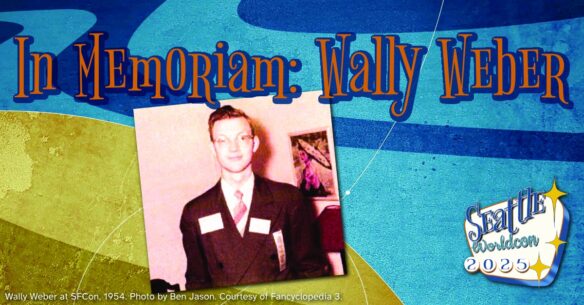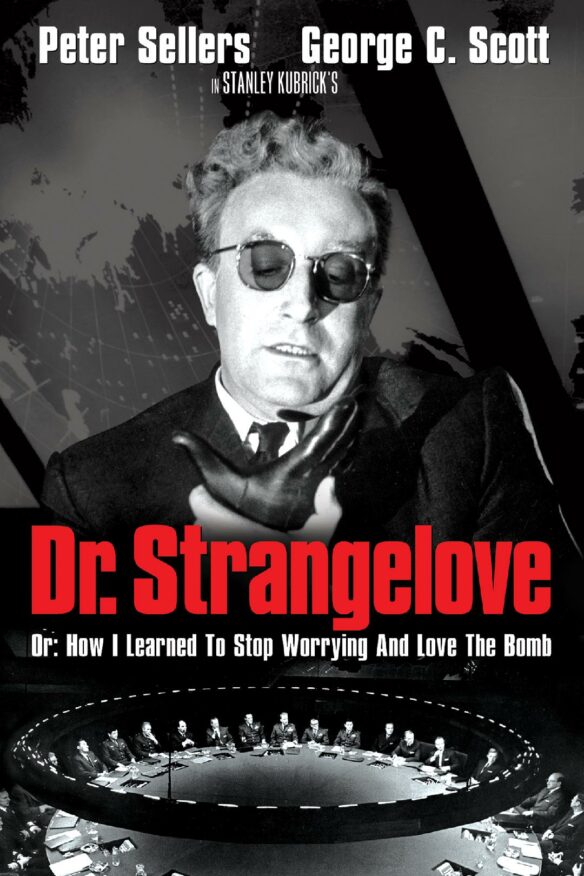(1) SPINRAD RETIRING ASIMOV’S BOOK COLUMN. Norman Spinrad today told his mailing list that his “On Books” column, which has appeared in Asimov’s since 1983, soon will end its run.
I thought it would be best to be the one to announce that “Speculative Literature?” will be the last “On Books” that it would be the last column to be published in ASIMOV’S magazine rather than have the editor Sheila Williams do it. First because I made the decision myself after almost half a century, not her or anyone else did it.
Not fired for any economical reason or anything but literary reasons which I think anyone who reads my last two “On Books” will under[stand] why when they read them whether they agree or not.
Dona could not live to see “Speculative Literature?” published but she lived to read it, and it was the last thing she worked with me one way or another and something she told me was that most real true literature these days was seldom appreciated by the masses, it was only fully appreciated and moved by truly literary readers and that has always been so.
Maybe so, but literature was central to the creation of culture, and cultures without speculative culture sooner or later end in the tarpits.
(2) CORALINE MUSICAL PRODUCTION CANCELLED. In the UK, “Stage adaptation of Coraline cancelled after allegations against Neil Gaiman” reports the Guardian.
A stage version of Neil Gaiman’s Coraline has been cancelled after allegations of sexual misconduct against the author.
The musical was to have been staged at Leeds Playhouse from 11 April to 11 May before touring to Edinburgh, Birmingham and Manchester.
In a joint statement on Wednesday, the co-production partners Leeds Playhouse, Royal Lyceum Theatre Edinburgh, Birmingham Rep and Home Manchester said: “We have decided our production of Coraline – a Musical will not proceed. After careful consideration, we feel it would be impossible to continue in the context of the allegations against its original author. Ticket holders have been contacted directly via email.”…
YouTuber MickeyJo Theatre devotes a 17-minute video not only to “Why the CORALINE musical is cancelled” but to considering why stage productions by or based on the work of Roald Dahl, J.K. Rowling – themselves now controversial – have gone ahead.
(3) WGA LIFETIME ACHIEVEMENT AWARD. “David Lynch To Posthumously Receive Writers Guild Laurel Award” – Deadline has the story.
Screenwriter and director David Lynch, who died this month, has been named the recipient of the Writers Guild of America West’s 2025 Laurel Award for Screenwriting Achievement.
The guild says he was aware of the honor and accepted several weeks before his January 15 passing. It will be presented by his Blue Velvet and Twin Peaks star Kyle MacLachlan at the WGA Awards ceremony on February 15 .
The guild’s lifetime achievement award is presented to members who have “advanced the literature of motion pictures and made outstanding contributions to the profession of the screenwriter.”
(4) A LIKING FOR LYCANTHROPY. Doris V. Sutherland does a fine review of “Wolf Man (2025)” as part of “Werewolf Wednesday”.
… Where the 1941 film did much to codify the werewolf genre, the new film makes a point out of throwing away many of the conventions initiated by its ancestor.
This is not a story concerned with deadly silver, ghostly pentagrams or rhymes about the brightness of the Autumn moon. Having pared down the cinematic lycanthrope, does Wolf Man ‘25 bring any innovations to the table?…
(5) MAIL CALL. Deep Cuts in a Lovecraftian Vein analyzes another correspondence between two Weird Tales figures in “Her Letters to August Derleth: Everil Worrell”.
…In one, she describes a meeting of the League of American Pen Women, which concludes:
“At the end of this meeting, I found myself trying to give them a slight glimpse into the Cult of Chulthu [sic]! Although I was never much more than a “Square” observer on the C of C, I did my best—since there seemed to be a “Need to Know.” I’m more at ease with ordinary witchcraft, vampirism and demonology—perhaps. But, leave us all hang together. (And now I’m one of the Old Ones myself, chronologically speaking.)
N’Gai ? ?
—Everil Worrell to August Derleth, 12 Mar 1967”
(6) WRITING CONTESTS RESPOND TO LA FIRES. The Tomorrow Prize and Green Feather Award submission deadline has been extended to February 28. The competitions are open to LA County high school students – see full Submissions & Guidelines at the link.

(7) WALLY WEBER (1929-2025). Chair of the 1961 Worldcon Wally Weber died January 23 at the age of 95 reports Seattle Worldcon 2025. Entering fandom in 1947, he joined Seattle’s “Nameless Ones” group when it began around 1949.

Weber co-edited Cry of the Nameless, three-time Hugo nominee and winner of the 1960 Best Fanzine Hugo. (F.M. Busby, Elinor Busby, and Burnett Toskey were the other co-editors.)
He chaired the 1961 Worldcon, Seacon, held in Seattle. In 1963 he was voted the Trans-Atlantic Fan Fund delegate.
Above all he made fandom fun, sometimes at the expense of its more earnest practitioners as in this example from a 1963 issue of Cry: “The Farley File Menace, exposed by Wally Weber”.
…Bruce [Pelz] refers to the caper as, “Farley File on Fandom,” and describes it as a project in which information about fans is recorded on punched cards in such a manner that standard sorting machines (to which both Pelz and [Ron] Ellik are supposed to have access) can be used to pick out those fans included in the file who have whatever it might be the sorter is searching for. Suppose, for example, you live in New York and you want to write a letter to Bruce Pelz in Los Angeles, but after you have sealed the envelope you discover you don’t have a stamp. Before the age of the farley file you would have had to go out in the cold (assume it’s five o’clock in the morning and it’s snowing like crazy outside), find a place that is open where you can buy a stamp, and pay for one. But now, with the farley file in existence, you can avoid this. You just call Bruce on the phone (it will only be two o’clock in the morning in Los Angeles) and ask him for the names of the fans in New York who have an accumulated collection of stamps. Bruce then gets dressed, drives over to the UCLA campus, lets himself in the building where the sorter is located, goes back home to pick up the punched cards he forgot, remembers Ron Ellik had borrowed them to make duplicates to replace the set the FBI had taken from Ron, drives to wherever it is that Ron lives, breaks into Ron’s home since Ron is gone for the weekend, gets reported by the neighbors and captured by the police, and by the time he gets out of jail the weather has cleared up in New York, you’ve been able to obtain a new supply of stamps at your leisure, and the letter has been delivered to Bruce right along with his last paycheck from UCLA where he has been fired for not showing up for work for two weeks….
(8) MEMORY LANE.
[Written by Paul Weimer.]
January 29, 1964 — Dr. Strangelove (premiered on this date)
By Paul Weimer: I had heard about Dr. Strangelove for years without ever quite managing to see it, in those early days before streaming took off. My family seemed lukewarm to the idea of me renting a videotape. And so I read about it, heard about it and wondered about it.
Finally in the late 90’s I got my chance. In the halcyon days of the early internet, I won a random contest for people who responded to an early column transplanted from the newspaper to the internet about movies that were less than two hours long. My comment won me a DVD copy of Dr. Strangelove.
Happy day, I could finally see the film.
I was stunned by the interesting angles and cinematography. I also had had no real conception that the movie was in black and white–I figure all the stills I saw were taken with a B&W camera, but I didn’t realize that the movie itself was in monochrome throughout. And my conception of the plot was a little off, too.
And then there was Fail-Safe. I had managed to see Fail-Safe and so when I saw Dr. Strangelove, I saw the similarities and parallels immediately. They are both extremely interesting movies, with different takes on the same question of Mutual Assured Destruction. But Strangelove I think is superior and that’s because of the humor.
The humor! It’s probably my favorite dark comedy of the period, and I had had heard it was darkly humorous but to see it on screen. Peter Sellers in three roles. George C. Scott. Sterling Hayden and his precious bodily fluids. Slim Pickens riding a bomb to glory and destruction. Mine shaft gaps. And on, and on.
And yes, it is in black and white, and the camera choices, angles, and cinematography are revelatory, powerful and considered at all times. The movie is one of the best filmed I’ve ever seen. Not quite as revolutionary as Citizen Kane, say, but that same sort of boldness.
It was robbed at the Oscars. Can you even remember My Fair Lady, the Best Picture winner that year?
And in our day and age (I need not explain more, do I?), the movie is ever more relevant, funny and true.

(9) COMICS SECTION.
- Saturday Morning Breakfast Cereal says the true message is hidden.
- Bizarro introduces a new Transformer.
- Dog Eat Doug has a planned trip.
- Speed Bump adds a new literary category.
(10) SEE IMAGINARY BOOKS. [Item by Steven French.] We’ve been here before but if any Filefolk happen to be in New York before Feb 15 or in San Francisco after March and have a hankering to see a reproduction of Death’s memoirs from the Discworld novels, then this is the exhibition for you: “Inside a Collection of ‘Imaginary’ Books” at Atlas Obscura.

ON A SNOWY SUNDAY AFTERNOON at the Center for Book Arts in Manhattan, Reid Byers is sitting in front of a group of students who have gathered for a very particular kind of book-making class.
Surrounded by the sturdy-looking tools of bookbinding—giant sheets of paper, a pegboard of hammers, a row of heavy book presses lining the windowsill—it’s easy to feel grounded in the materiality of the medium. But on the projector screen, a slide reads, “Collecting the imaginary”.
(11) THE CLAWS THAT CATCH. “AI haters build tarpits to trap and trick AI scrapers that ignore robots.txt” – Ars Technica really shares little about how it’s done in the article, but it does suggest where you could learn more.
Last summer, Anthropic inspired backlash when its ClaudeBot AI crawler was accused of hammering websites a million or more times a day.
And it wasn’t the only artificial intelligence company making headlines for supposedly ignoring instructions in robots.txt files to avoid scraping web content on certain sites. Around the same time, Reddit’s CEO called out all AI companies whose crawlers he said were “a pain in the ass to block,” despite the tech industry otherwise agreeing to respect “no scraping” robots.txt rules.
Watching the controversy unfold was a software developer whom Ars has granted anonymity to discuss his development of malware (we’ll call him Aaron). Shortly after he noticed Facebook’s crawler exceeding 30 million hits on his site, Aaron began plotting a new kind of attack on crawlers “clobbering” websites that he told Ars he hoped would give “teeth” to robots.txt.
Building on an anti-spam cybersecurity tactic known as tarpitting, he created Nepenthes, malicious software named after a carnivorous plant that will “eat just about anything that finds its way inside.”…
… “A link to a Nepenthes location from your site will flood out valid URLs within your site’s domain name, making it unlikely the crawler will access real content,” a Nepenthes explainer reads….
According to ZADZMO code, “It [Nepenthes] works by generating an endless sequences of pages, each of which with dozens of links, that simply go back into a the tarpit. Pages are randomly generated, but in a deterministic way, causing them to appear to be flat files that never change. Intentional delay is added to prevent crawlers from bogging down your server, in addition to wasting their time. Lastly, optional Markov-babble can be added to the pages, to give the crawlers something to scrape up and train their LLMs on, hopefully accelerating model collapse.”
Returning to Ars Technica:
…When software developer and hacker Gergely Nagy, who goes by the handle “algernon” online, saw Nepenthes, he was delighted. At that time, Nagy told Ars that nearly all of his server’s bandwidth was being “eaten” by AI crawlers.
Already blocking scraping and attempting to poison AI models through a simpler method, Nagy took his defense method further and created his own tarpit, Iocaine. He told Ars the tarpit immediately killed off about 94 percent of bot traffic to his site, which was primarily from AI crawlers. Soon, social media discussion drove users to inquire about Iocaine deployment, including not just individuals but also organizations wanting to take stronger steps to block scraping.
Iocaine takes ideas (not code) from Nepenthes, but it’s more intent on using the tarpit to poison AI models. Nagy used a reverse proxy to trap crawlers in an “infinite maze of garbage” in an attempt to slowly poison their data collection as much as possible for daring to ignore robots.txt….
Taking its name from “one of the deadliest poisons known to man” from The Princess Bride, Iocaine is jokingly depicted as the “deadliest poison known to AI.” While there’s no way of validating that claim, Nagy’s motto is that the more poisoning attacks that are out there, “the merrier.” He told Ars that his primary reasons for building Iocaine were to help rights holders wall off valuable content and stop AI crawlers from crawling with abandon.
(12) CONTEMPORARY COMBAT IMAGINED. “Robot dog battles drone in fireworks fight, sparking future warfare concerns”. (View the video on YouTube here: “Future of #war”.)
A robotic dog fighting an aerial drone is the future of warfare that one would expect in science fiction.
But a video depicting this real-life scene has gone viral on social media sites in China and brought up discussions about a future where machines engage in warfare and what it would take to become the ultimate victor.Fighting with drones has gone from futuristic to a common theme in warfare. At the turn of this century, the US flew its first drones with wings as wide as 66 feet (20 m) and a cruising altitude of 50,000 feet (15,000 m), but it cost millions of dollars to build one.
In just over two decades, drones have become smaller, nimbler, and so inexpensive to produce that they have become dispensable.
Last month, the Ukrainian defense ministry confirmed that its armed forces used more than 1.2 million drones in 2024 during the ongoing Russia-Ukraine War. On its part, Russia has produced over 1.4 million drones as both sides deploy hundreds of drones in their attacks….
(13) WHEN “SF” STANDS FOR STICKY FINGERS. Collider chronicles “How the Only Star Trek Prop To Survive Two Movies Made Its Way to the Small Screen”.
It’s not uncommon for actors to take home a prop that holds special significance for their character once filming wraps, or for eager fans to snatch up iconic items at an auction. The captain’s chair from the Enterprise bridge might seem like a less obvious — and more unwieldy — prop for someone to take home, but hauling a large piece of furniture around apparently hasn’t stopped certain people from snatching up Captain James T. Kirk‘s (William Shatner) chair over the years. Only one captain’s chair ever made it from one Star Trek movie to the next without being stolen, and that same chair lived long enough to unconventionally grace the small screen.
In 2013, actor and stand-up comedian Darrin Rose starred in a car insurance commercial tied to director J. J. Abrams‘ second Star Trek reboot film, Star Trek: Into Darkness. The ad — also starring Mr. and Mrs. Smith and Blue Eye Samurai’s Maya Erskine — spoofed the frequent ship-to-ship battles for which the franchise is known. After an alien vessel bumps into a Federation starship, the crew prepares for a hostile battle. Instead, the other captain awkwardly apologizes for grazing them and offers to trade insurance information.
According to a dual post on Rose’s Facebook and Instagram, the ad used the same captain’s chair prop from Abrams’ 2009 Star Trek movie as well as its follow-up, Into Darkness. Because Abrams’ company, Bad Robot, produced the commercial, they automatically had access to the movies’ props, costumes, and makeup, and replicated a high-budget starship bridge — which makes the already clever tie-in commercial even funnier. As for how Chris Pine‘s Enterprise chair factors into the ad, Rose learned during filming that every other captain’s chair from previous Trek movies had met an unfortunate end….
[Thanks to Steven French, Kathy Sullivan, Teddy Harvia, Mark Roth-Whitworth, Mike Kennedy, Andrew Porter, John King Tarpinian, Chris Barkley, Cat Eldridge, SF Concatenation’s Jonathan Cowie for some of these stories. Title credit belongs to File 770 contributing editor of the day Jeff Smith and Neil Young.]






















